Exploring the World of Small Nautical Flags


Intro
Small nautical flags have a rich history, playing a significant role in maritime communication. They represent safety, navigation, and even cultural heritage. These flags are not just colorful pieces of fabric. They are tools that convey messages between vessels, ensuring safety and clarity at sea. Their design, meaning, and practical use have evolved through time, making them essential in a variety of maritime contexts.
Understanding the importance of small nautical flags opens a window into maritime culture. This article will explore the historical context of these flags, the standards that govern their usage, and their practical applications in modern boating and sailing. We will also discuss how these flags are designed and manufactured, along with the materials used to ensure their durability. Lastly, we will examine the cultural significance of nautical flags in events like regattas, providing readers a comprehensive view of their relevance today.
Preamble to Small Nautical Flags
Small nautical flags serve as important tools in maritime communication. Their significance extends beyond mere decoration; they represent a complex system of signals that sailors and ship operators have relied on for centuries. Understanding these flags enhances safety at sea and enriches the overall experience of navigating nautical waters.
Definition and Overview
Small nautical flags are typically rectangular pieces of fabric that convey specific messages in maritime contexts. These flags come in various colors and patterns, each with distinct meanings that facilitate communication between vessels. They are utilized in signaling between ships, during regattas, and for conveying safety messages in a wide range of marine situations.
The use of these flags allows for silent communication, which is critical in scenarios where radio communications may be impractical or unavailable. Moreover, they follow standardized protocols governed by organizations like the International Maritime Organization, ensuring that the meaning of each flag is universally understood.
Historical Background
The history of small nautical flags dates back hundreds of years. In the early days of sailing, mariners relied on visual cues to signal intentions and relay information. As maritime activities expanded, the need for a systematic method of communication became apparent. This led to the development of signal flags for various purposes.
During the 17th century, these signaling practices evolved significantly. The British Royal Navy played a pivotal role in standardizing flag systems for effective maritime communication. This framework not only improved coordination among ships but also established a common language that transcended linguistic barriers.
The importance of nautical flags became further pronounced with the rise of sailing vessels traversing global waters. Flags were not only practical tools for communication but also symbols of maritime culture and heritage. As sailing techniques advanced, so did the complexity of flag signals, resulting in the integrated and systematic approach we see today.
Types of Nautical Flags
The Types of Nautical Flags section explores the variety of flags used in maritime settings. Each type serves distinct purposes and communicates specific messages within the sailing community. Understanding these classifications enhances both safety and operational efficiency on the water. This section will detail different flag types, focusing on their roles, meanings, and applications.
International Signal Flags
International Signal Flags are a standardized set of flags recognized globally. These flags consist of twenty-six distinct flags, each representing a letter of the alphabet. These flags can be used to spell out messages when flown together. The A through Z signal flags allow vessels to communicate information quickly and effectively across distances.
For instance, the use of specific flags indicates maneuvers or conveys urgent messages. Flag "B," or Bravo, signals to other ships that the vessel is taking on explosive or dangerous cargo. Understandably, this knowledge is vital for safety protocol in busy shipping lanes.
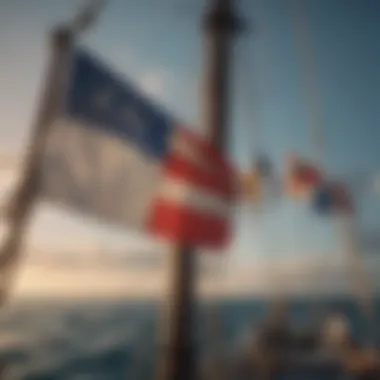
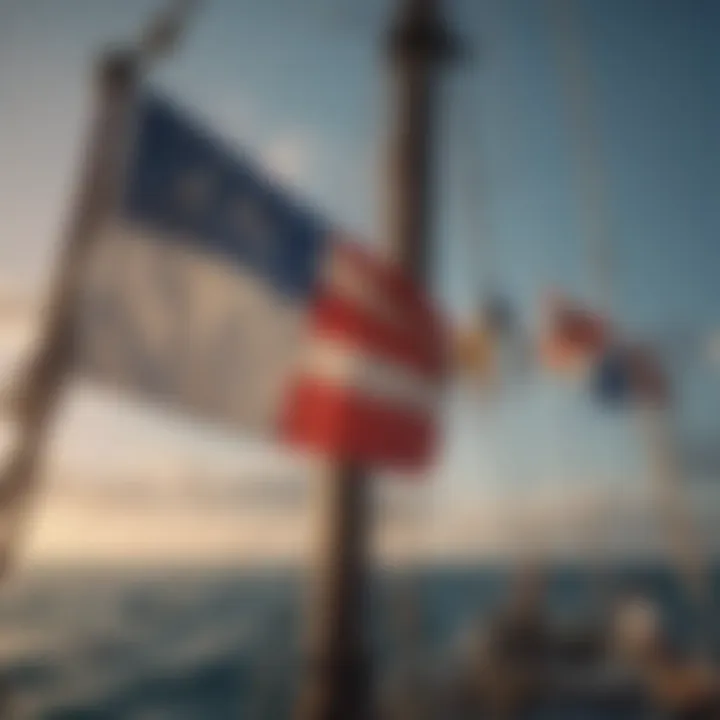
The effectiveness of international signal flags lies in their universal recognition, facilitating cross-linguistic communication among diverse maritime vessels. The reliance on visuals minimizes miscommunication that can arise from audible signals, especially in noisy environments.
Local and National Flags
Local and National Flags symbolize pride, identity, and jurisdiction in maritime scenarios. These flags may vary greatly, reflecting the heritage of their respective nations or localities. Local flags often represent clubs, harbors, or regions, while national flags assert the country under whose laws a vessel operates.
In many cases, these flags are flown on boats to signify nationality, helping to avoid confusion in international waters. Moreover, they are essential in demonstrating allegiance to maritime laws and regulations specific to a country or local harbor. For instance, the United States flag carried on vessels in American waters signifies adherence to U.S. maritime law.
Understanding and recognizing these flags is critical for safe navigation and respect for diverse maritime traditions across waters. It fosters camaraderie among maritime enthusiasts and visitors alike.
Burgee and Ensign Flags
Burgee and Ensign Flags are distinguished by their specific roles in the sailing community. The burgee is typically used by yacht clubs and sailing organizations. It serves as a badge of honor, indicating membership and allegiance. The design usually reflects the organization's identity or heritage. Members proudly fly their burgees during regattas and local sailing events to promote a sense of community.
Conversely, ensigns are official flags that indicate a ship’s nationality and the vessel's registration. The ensign must be flown at the stern of the boat while in international waters. Each nation has distinct ensign protocols, which sailors must follow diligently. For example, the Union Jack serves as the ensign for the United Kingdom.
In summary, burgees and ensigns represent distinct facets of maritime culture, helping identify vessels and their affiliations while fostering community and safety on the water.
Communication with Nautical Flags
Nautical flags serve a critical role in uniting vessels on the open water. They enable smooth and efficient communication, which is especially crucial in busy marinas or during regattas. Understanding the nuances behind these flags enhances safety and ensures that all sailors are on the same page. The purpose of using flags is to transmit information without the reliance on verbal commands, which may not always be feasible in a noisy environment or during inclement weather.
Effective communication involves both conveying messages accurately and deciphering the flags being used. This dual necessity reinforces the importance of proper training and awareness among mariners. The following sections will explore various aspects of flag signals and their meanings, maritime navigation applications, and the specific emergency signals that are vital in distress situations.
Flag Signals and Their Meanings
Flag signals are a rich language of symbols, each conveying specific messages. The International Code of Signals defines a system where each letter of the alphabet corresponds to a flag, allowing for a wide array of messages. For example, the flag representing 'A' indicates "I have a diver down; keep well clear at slow speed." Understanding these flags is more than just knowledge; it is about fostering a culture of safety on the water.
In addition to their standard meanings, many local boating communities have specific flags to indicate local hazards or particular customs. It is essential for all boaters to be familiar with these variations to ensure safe navigation. As we delve deeper into this subject, a clear understanding of flag signals emerges as a vital component of maritime activities.
Applications in Maritime Navigation
The application of nautical flags transcends simple messaging; it plays an integral role in maritime navigation. First, flags signify a vessel's intentions, such as whether it is anchored, under way, or wishing to engage in a maneuver. This helps to manage traffic on marinas and waterways efficiently, minimizing the likelihood of accidents.
Furthermore, flags may also indicate environmental conditions. For instance, a yellow flag signifies potential caution due to weather changes or presence of hazardous elements in the water. This aids vessels in making informed decisions while navigating through potentially dangerous scenarios, enhancing the overall safety of maritime travel.
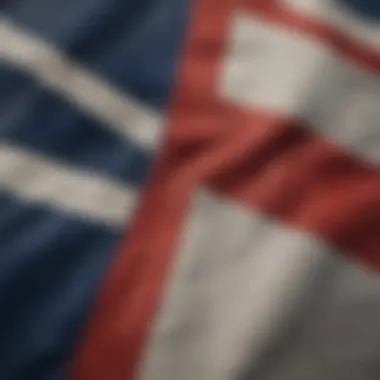
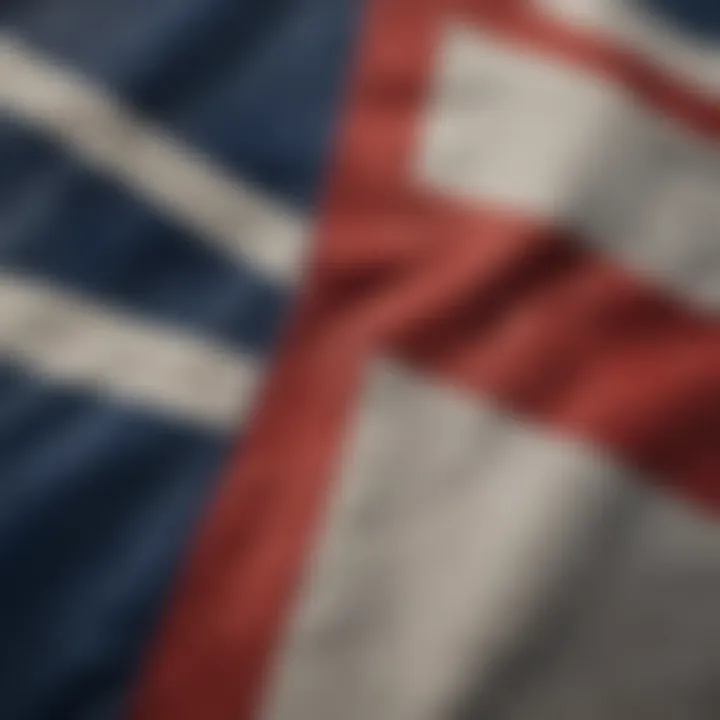
Emergency Signals
In emergencies, the use of nautical flags becomes even more critical. Specific flag signals are universally recognized as distress signals. For example, the use of the signal flag 'N' combined with 'C' indicates an urgent need for assistance. Other combinations exist, and it is paramount that all sailors understand these alerts.
Knowing these signals can save lives. When a vessel runs into trouble, every second counts. A well-practiced crew will know how to display these flags effectively, thereby alerting nearby vessels to the misfortune. Understanding and utilizing these emergency signals is essential in risk management for anyone who ventures onto the water.
Design and Production of Nautical Flags
The design and production of nautical flags play a crucial role in ensuring efficient communication at sea. Their visual clarity, color coding, and symbolic representations provide vital information to sailors. The methods used to produce these flags must align with their intended purpose. Considerations such as visibility, durability, and ease of recognition are essential in the design process.
Materials Used
The materials chosen for making nautical flags greatly influence their performance in marine environments. Common materials include:
- Polyester: Known for its lightweight properties and resistance to UV fading.
- Nylon: Often favored for its strength and ability to maintain color, ideal for flags that experience high winds.
- Cotton: less common in professional contexts but used in traditional flags due to its historical significance.
Selection of the appropriate fabric is vital. A flag should withstand harsh weather and remain vibrant while being flown. The stitching technique also plays a role and should ensure that it does not easily fray or tear under stress.
Durability and Maintenance
Durability is a non-negotiable aspect when it comes to nautical flags. Exposure to saltwater, sun, and wind can degrade their quality over time. Regular maintenance is necessary to keep flags operational, which may include:
- Washing: Flags can accumulate dirt and salt, so periodic washing helps maintain their appearance and functionality.
- Inspecting for Damage: Regular checks should be conducted for signs of wear or fraying.
- Proper Storage: When not in use, flags should be stored in a dry environment to prevent mold and mildew.
Understanding the life expectancy of the materials used can aid sailors in planning replacements and ensuring that their flags remain reliable is crucial.
Technological Advances in Flag Making
In recent years, technological advancements have greatly impacted the production of nautical flags. Innovations in manufacturing processes and materials have led to the following improvements:
- Digital Printing: Allows for high-quality designs that are vibrant and long-lasting.
- Advanced Materials: Development of synthetic fabrics with higher durability and lighter weights is transforming the flag industry.
- Automation in Production: Enhancements in machinery have sped up production times, making flags more accessible to a variety of users.
These advancements not only enhance the functionality and aesthetic appeal of nautical flags but also contribute to more sustainable practices in production, addressing environmental concerns among maritime enthusiasts.
In summary, the design and production of nautical flags encompass various elements. They must consider material selection, durability, maintenance, and technological innovations. Each factor plays a significant role in ensuring that these flags effectively serve the sailors and enthusiasts who rely on them for communication and tradition.
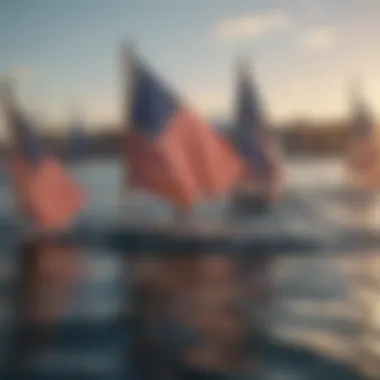
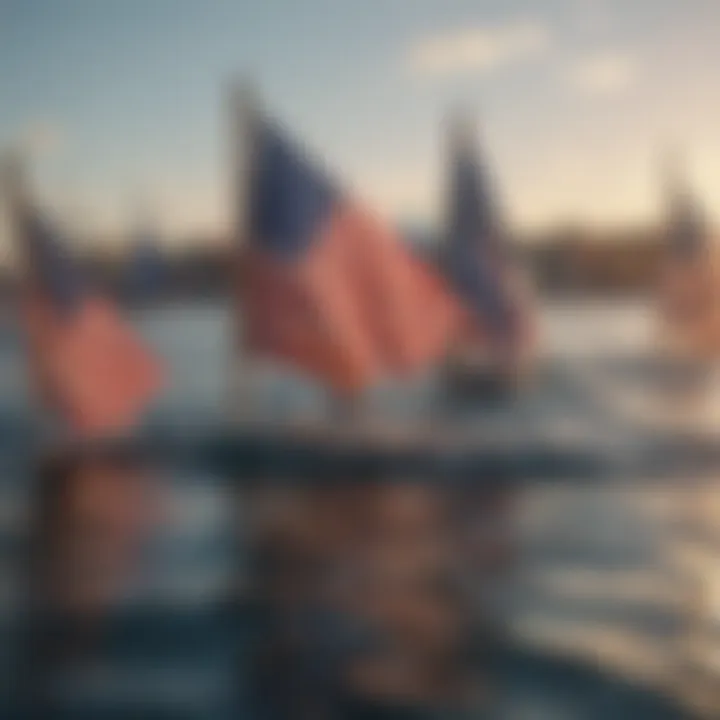
Cultural Significance of Nautical Flags
The cultural significance of nautical flags extends beyond their practical uses. They encapsulate a rich tapestry of maritime history, tradition, and artistic expression. In various cultures, flags signify pride, heritage, and a sense of belonging within the maritime community. This section delves into specific elements that highlight their importance in maritime traditions, modern regattas, and artistic representations.
Flags in Maritime Traditions
Historically, flags have played a pivotal role in maritime traditions. They were used as tools for identification, communication, and sometimes even as symbols of power. Different nations incorporated unique designs and colors into their flags, reflecting their maritime identity.
From ancient times, sailors relied on flags to signal their presence, intentions, and messages to other vessels. Many maritime traditions, like the use of the Jolly Roger, highlight how flags represent cultural narratives and folklore. These flags often tell stories and evoke emotions among sailors and onlookers alike.
Flags in Modern Regattas
In modern times, small nautical flags continue to hold cultural significance, especially during regattas. Yacht clubs and sailing communities use flags to foster camaraderie and competition. Flags showcased during these events not only identify participating vessels but also represent club identity and sailing heritage.
Regatta committees use flags to convey important signals about race starts, hoist flags to indicate course changes, and relay crucial information to competitors. This creates an atmosphere of excitement and enhances the visual spectacle of sailing events, engrossing both participants and spectators.
Artistic Representations
Artistic representations of nautical flags can also be found across various media. Artists have incorporated flag designs into paintings, sculptures, and textile arts, celebrating their aesthetic appeal. Nautical flags serve as symbols in art that often prompt reflections on maritime culture, identity, and environmental issues.
Through exhibitions and installations, flags have become mediums for addressing topics like climate change and ocean conservation. The reinterpretation of nautical flags in contemporary art demonstrates their adaptability and enduring relevance in cultural discourse.
Nautical flags are not merely tools for communication; they are also symbols of history, identity, and artistic expression.
In summary, the cultural significance of small nautical flags is profound and multifaceted. Their rich history, roles in modern sporting events, and representation in art underscores their lasting impact on maritime cultures and beyond.
Epilogue
Recap of Nautical Flag Importance
Small nautical flags play an essential role in promoting safety and effective communication on the water. They help convey important messages among vessels, aid in navigation, and signify identity and status. Flag semantics is another vital aspect; each flag has a specific meaning, enabling sailors to convey messages without verbal communication. Understanding these flags is crucial, especially in busy maritime environments.
- The importance of small nautical flags includes:
- Safety: Proper use of flags can prevent accidents.
- Communication: Flags serve a unique, efficient way to exchange information.
- Tradition: They hold historical relevance, representing the evolution of maritime practices.
Future of Nautical Flags in Communication
As technology continues to advance, the future of nautical flags may shift. Digital communication methods, such as VHF radios and AIS, are becoming widespread. However, the tactile and visual significance of flags remains irreplaceable. They serve well in situations where electronic communication may fail.
In essence, small nautical flags continue to maintain their relevance in the modern age. They embody a rich history, practical communication needs, and an artistic tradition. While navigating new waters may include modern technology, the foundational principles of communication via flags will persist, reminding sailors of their roots.







